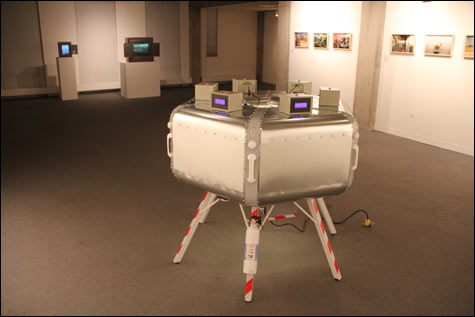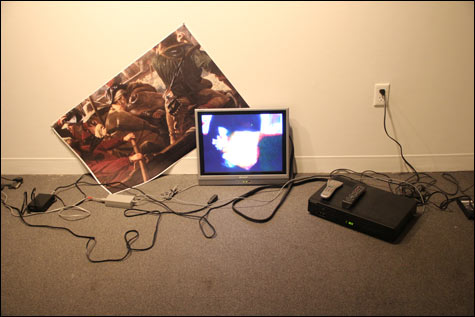
MUTANT OFFSPRING Leone's Particle Dust Accelerator. |
It seems life should feel easy with all our faster foods and whiter teeth and smarter bombs, but despite — or perhaps because of — all our modern conveniences, we feel as awkward and hapless as ever. That is one unspoken theme that viewers might draw from the five local artists exhibiting at the Chazan Gallery at the Wheeler School (228 Angell Street, Providence, through December 8).
Lucky Leone of Providence presents his Particle Dust Accelerator, a hexagonal arrangement of metal ventilation pipes with lights, buttons, and handles on the sides, and caution-striped legs. It looks like the mutant offspring of ventilation shafts, construction barricades, and a lunar lander.
On top are little boxes with blue screens that appear to offer data about whatever the humming machine is doing: "chamber temperature," "wind vector index," and so on. Press red buttons on the boxes and the screens flash the text of a story about a grad student roped by his department head into helping an undergrad attempt to build a perpetual motion machine, no matter the impossibility of the task. He gets out of it by ducking into an elevator, and never seeing the student again. "Am I a bad person/teacher or a smart one? Can I be both?" the blue screens ask. It's an elaborate sculpture for a wispy, sad sack fantasy gag.
Tina Tryforos of Pawtucket focuses on the feeling "that something is amiss" in photographs of taxidermied critters in natural history museums and live snakes, lizards, and leopards in zoos. Her attention is drawn to the often awkward, half-assed results of zookeepers and curators' attempts to make the scenes look real. In one memorably sad photo, a giraffe presses its head against a wall painted to look like a savannah. It's literally about butting up against the lovely illusions we create to hide dreary reality.

HAPHAZARD SPRAWL Montford's My Wife. |
James Montford of Providence, the director of Rhode Island College's Bannister Gallery, arranges a DVD player, television, cables, and remote controls across the floor in a haphazard sprawl for his installation My Wife. Leaning crookedly against the wall is a pixilated detail of Emanuel Leutze's famous 1850 painting of Washington crossing the Delaware, focusing on a man in buckskin leggings who is sometimes interpreted to be a Native American. Pasted onto the fellow's leather satchel is a black Sambo cartoon face.
The television shows a brief looping video of a face projected onto a person's back as text scrolls across a wall: "Black is evil. Black is dismal. Black is gloomy. White is free from color." The audio offers a fugue of overlapping voices that seemingly references Montford's own diverse ancestry: "My face, my family is white, black, Native American. My son. George Washington Crossing the Delaware. My face is. My family is black, white . . . ." It feels like an incantation, but for what?
Montford's art is known for its provocative use of racial slurs and symbols. In one performance, he imitated a lynching. In 1995, he protested the absence of artists of color in a Hartford, Connecticut, exhibit by scrawling "No Coons Here" on the gallery wall. He posed as a live cigar store Indian in front of a statue of Abe Lincoln in Buffalo in 2003.